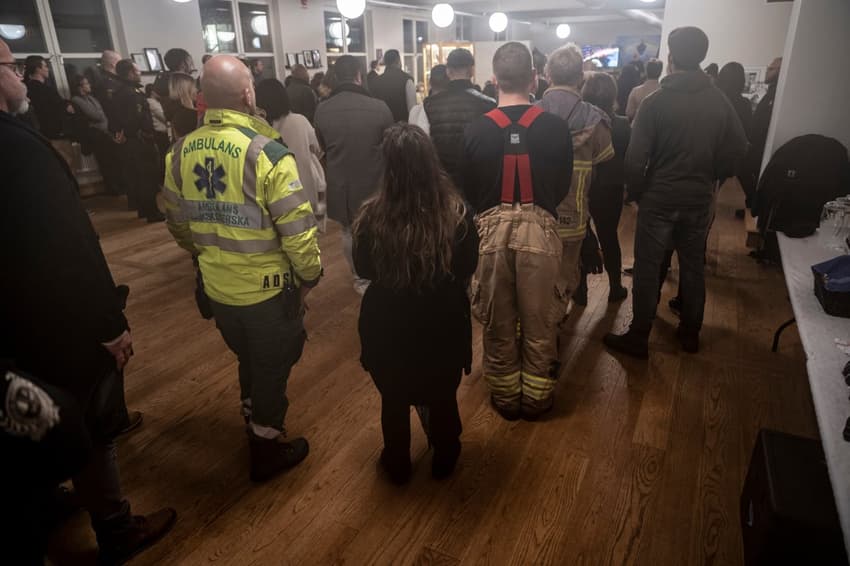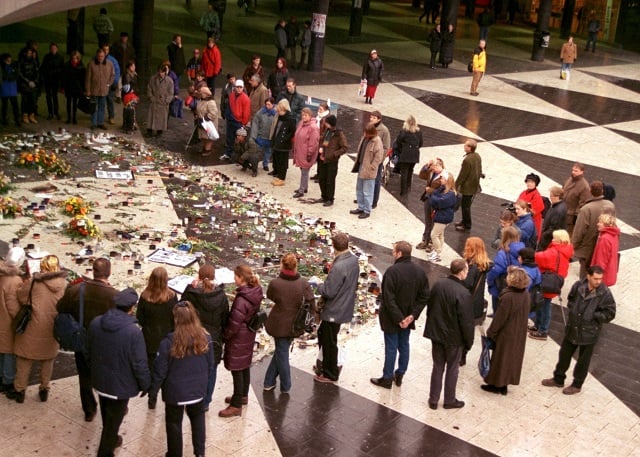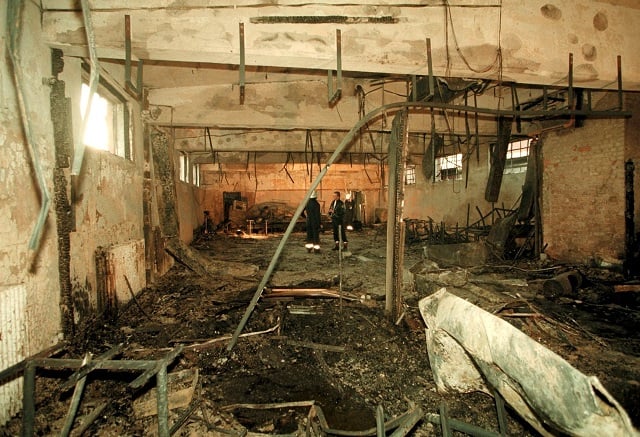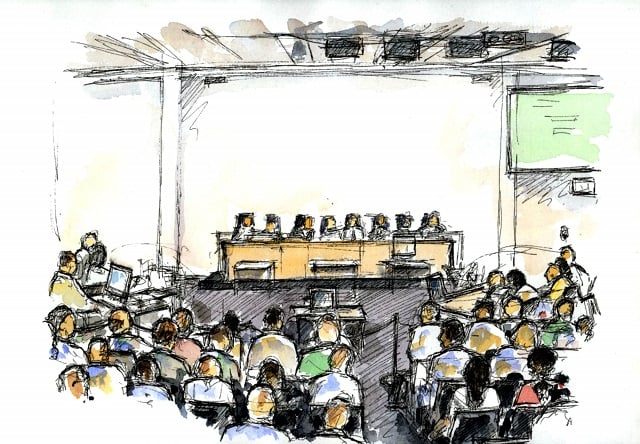The story of the biggest fire disaster in Swedish history

At a Halloween party in Gothenburg in 1998, a fire started by four youths led to one of the deadliest disasters of modern Swedish history. Sixty-three young people lost their lives and many more were injured.
Between 340 and 400 people, many of them teenagers, had gathered in a building in the harbour district of Gothenburg to celebrate Halloween. A Macedonian cultural organisation had rented out its premises for the night, with the external organisers telling authorities the occasion was a birthday party for 50 people.
The fire broke out around 20 minutes before midnight. It originated in an emergency exit stairwell and at first went unnoticed by the partygoers, who put the smoke and smell down to the smoke machine. Even after one of the DJs noticed the fire and warned the attendees to start calmly leaving the venue, many didn't realise the scale of the disaster.
Once the smoke started to fill the dance room, there was chaos.
The building was intended to host a maximum of 150 people, so it was severely overcrowded. The emergency exit had been blocked by chairs and tables, stacked away to clear space in the main room, and because the fire had started here this exit was unusable. As a result, dozens of people tried to escape via the single remaining stairway, its door less than a metre wide.

A moment of silence held at Sergels Torg in central Stockholm days afterwards. Photo: Tandogan Uysal/SCANPIX
The first call to emergency services came at 11.42pm, with the caller repeatedly asking for someone to "come quickly". Minutes after the first emergency call, the first firefighters reached the scene, where the first police car had already arrived and would be joined by two ambulances seconds later.
Upon arrival, the firefighting team called for backup and reported that some people were already trying to escape by jumping out of the windows, five metres above ground level. Almost 40 people survived by jumping, but many of them seriously injured themselves in doing so. Several firefighters described the scenes that greeted them as "completely unreal", a Swedish Civil Contingencies Agency (MSB) report states.
At the time emergency services arrived, there were still around 100 people in the building, of whom rescuers were able to save around 40, both through windows and via the main staircase. Many of the partygoers assisted with rescue efforts although others, frustrated at what they considered the slow pace of rescue work, became aggressive and even violent towards emergency services workers.
In total, 63 people were killed and over 200 more were injured in the fire, 74 requiring intensive care. The youngest victim was aged just 12 and all were under 20. Carbon monoxide poisoning was found to be the cause of death in all cases, while some of the injuries were caused by other factors including burns, impact with the ground after jumping from the windows, or being crushed while trying to escape.

The burned-out venue. Photo: Roger Lundsten/BLR-Fotograferna/TT
Police investigations began at around 3am, one hour after the fire was extinguished, and the following day was declared a day of mourning in Gothenburg.
At first, it was unclear whether the fire had been started deliberately or by accident and it sparked a massive police operation. Police interviewed around 1,500 people and offered a three million kronor reward for any information that might help establish the fire's cause.
Because most of the victims had a foreign background, there were fears that the fire may have been caused deliberately as a xenophobic act. Flyers apparently attempting to stoke the tensions appeared around the city in the days afterwards, saying "60 young immigrants have died, now 60 Swedes will die".
It later emerged that four young men were behind the arson attack, and were found guilty of the act by a court almost two years later. The men, all of whom were born in Iran, were accused of pouring flammable liquid over chairs stacked in a stairway before setting them alight, following an argument over the event's entry fee.
The alleged fire-starter was sentenced to eight years in prison, while two other members of the group received six-year sentences (later increased to seven) and the fourth to juvenile detention as he was aged under 18 at the time. The judgment said the four acted "with complete indifference" to the danger their actions posed.

A courtroom sketch from the trial. Picture: Anders Lyon
The sentence gave survivors and the victims' relatives some closure, and today a granite memorial commemorates the victims, with each of their names engraved in gold. The municipality funded renovations of the destroyed premises, which reopened three years after the disaster as a memorial site, and each year a memorial service is held in Gothenburg.
An organisation set up to support the victims' families, Brandoffrens anhöriga (Boa), has also supported victims of similar incidents worldwide, as well as working to raise awareness of how small fires can spread quickly and fatally.
"I hope we can keep our friends' spirits alive by going forward in a symbolic way, with redemption and building bridges across cultural-ethnic borders" Rozbeh Aslanian, spokesperson for the relatives of the fire victims, told the TT newswire ahead of the 20-year anniversary.
Article first published in 2018 and updated in 2023
Comments
See Also
Between 340 and 400 people, many of them teenagers, had gathered in a building in the harbour district of Gothenburg to celebrate Halloween. A Macedonian cultural organisation had rented out its premises for the night, with the external organisers telling authorities the occasion was a birthday party for 50 people.
The fire broke out around 20 minutes before midnight. It originated in an emergency exit stairwell and at first went unnoticed by the partygoers, who put the smoke and smell down to the smoke machine. Even after one of the DJs noticed the fire and warned the attendees to start calmly leaving the venue, many didn't realise the scale of the disaster.
Once the smoke started to fill the dance room, there was chaos.
The building was intended to host a maximum of 150 people, so it was severely overcrowded. The emergency exit had been blocked by chairs and tables, stacked away to clear space in the main room, and because the fire had started here this exit was unusable. As a result, dozens of people tried to escape via the single remaining stairway, its door less than a metre wide.

A moment of silence held at Sergels Torg in central Stockholm days afterwards. Photo: Tandogan Uysal/SCANPIX
The first call to emergency services came at 11.42pm, with the caller repeatedly asking for someone to "come quickly". Minutes after the first emergency call, the first firefighters reached the scene, where the first police car had already arrived and would be joined by two ambulances seconds later.
Upon arrival, the firefighting team called for backup and reported that some people were already trying to escape by jumping out of the windows, five metres above ground level. Almost 40 people survived by jumping, but many of them seriously injured themselves in doing so. Several firefighters described the scenes that greeted them as "completely unreal", a Swedish Civil Contingencies Agency (MSB) report states.
At the time emergency services arrived, there were still around 100 people in the building, of whom rescuers were able to save around 40, both through windows and via the main staircase. Many of the partygoers assisted with rescue efforts although others, frustrated at what they considered the slow pace of rescue work, became aggressive and even violent towards emergency services workers.
In total, 63 people were killed and over 200 more were injured in the fire, 74 requiring intensive care. The youngest victim was aged just 12 and all were under 20. Carbon monoxide poisoning was found to be the cause of death in all cases, while some of the injuries were caused by other factors including burns, impact with the ground after jumping from the windows, or being crushed while trying to escape.

The burned-out venue. Photo: Roger Lundsten/BLR-Fotograferna/TT
Police investigations began at around 3am, one hour after the fire was extinguished, and the following day was declared a day of mourning in Gothenburg.
At first, it was unclear whether the fire had been started deliberately or by accident and it sparked a massive police operation. Police interviewed around 1,500 people and offered a three million kronor reward for any information that might help establish the fire's cause.
Because most of the victims had a foreign background, there were fears that the fire may have been caused deliberately as a xenophobic act. Flyers apparently attempting to stoke the tensions appeared around the city in the days afterwards, saying "60 young immigrants have died, now 60 Swedes will die".
It later emerged that four young men were behind the arson attack, and were found guilty of the act by a court almost two years later. The men, all of whom were born in Iran, were accused of pouring flammable liquid over chairs stacked in a stairway before setting them alight, following an argument over the event's entry fee.
The alleged fire-starter was sentenced to eight years in prison, while two other members of the group received six-year sentences (later increased to seven) and the fourth to juvenile detention as he was aged under 18 at the time. The judgment said the four acted "with complete indifference" to the danger their actions posed.

A courtroom sketch from the trial. Picture: Anders Lyon
The sentence gave survivors and the victims' relatives some closure, and today a granite memorial commemorates the victims, with each of their names engraved in gold. The municipality funded renovations of the destroyed premises, which reopened three years after the disaster as a memorial site, and each year a memorial service is held in Gothenburg.
An organisation set up to support the victims' families, Brandoffrens anhöriga (Boa), has also supported victims of similar incidents worldwide, as well as working to raise awareness of how small fires can spread quickly and fatally.
"I hope we can keep our friends' spirits alive by going forward in a symbolic way, with redemption and building bridges across cultural-ethnic borders" Rozbeh Aslanian, spokesperson for the relatives of the fire victims, told the TT newswire ahead of the 20-year anniversary.
Article first published in 2018 and updated in 2023
Join the conversation in our comments section below. Share your own views and experience and if you have a question or suggestion for our journalists then email us at [email protected].
Please keep comments civil, constructive and on topic – and make sure to read our terms of use before getting involved.
Please log in here to leave a comment.